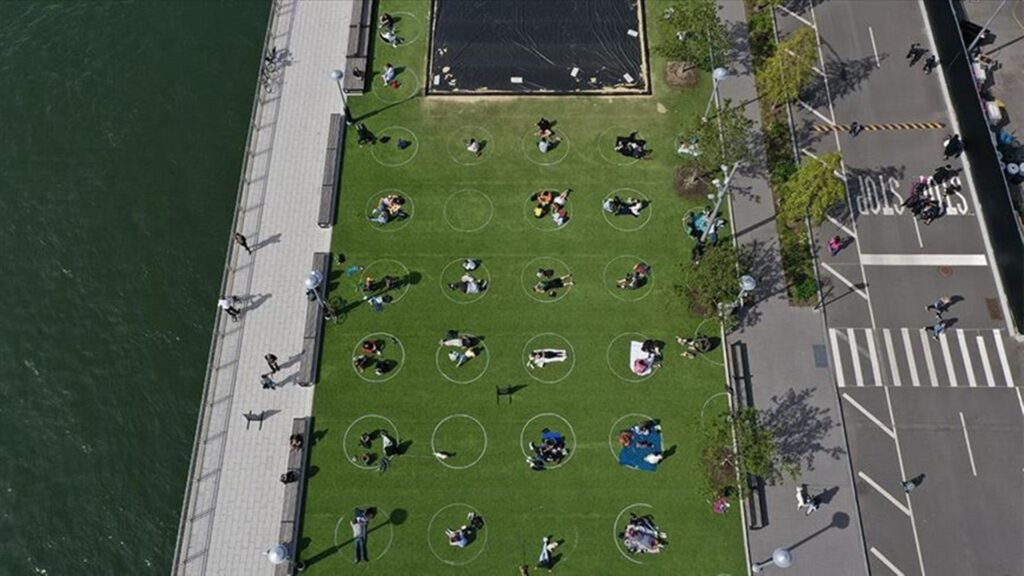They could have been a quirky play on the name Domino Park. But the large, painted circles — spaced six feet apart — on the grass of one of New York City’s newest sunbathing spots serve a very specific purpose.
They’re there to encourage social distancing as the city contends with almost 200,000 cases of Covid-19.
Park goers were pictured lazing in circles over the weekend at Domino Park, a five-acre recreational area on the Brooklyn waterfront that features fountains, a fog bridge, and courts for bocce and beach volleyball.
It’s built on the site of the old Domino Sugar Refinery, which dates back to 1856 and at one point produced most of America’s refined sugar.
Residents of New York City are still being advised to stay home if possible, and wear a face mask if they have to go out.
Privately-owned Domino Park is not managed by the New York City Department of Parks and Recreation, which is why the circles haven’t appeared across the city.
But the park is not alone in its use of simple geometric shapes to change human behavior.
In the last few months, circles, crosses and lines have appeared in shops, post offices, restaurants, cafes and other businessesas part of experimental measures to encourage people to stay at least six feet — or 1.5 meters — apart, depending on the country.
Never before have there been so many design cues on where we can and can’t sit, stand or line up.
Public benches have been taped off, public exercise equipment closed and plastic shields erected on shop counters. Restaurants have spaced out tables to meet restrictions on the number of customers they can serve, with some adopting even more extreme measures, including pool-noodle hats in one German café and “bumper tables” in Maryland.
Designers have also been proposing future concepts, including plexiglass dividers for public benches and “Gastro Safe Zones” for alfresco diners.
Roads are changing, too. Temporary bike lanes have been created in cities like Berlin, Paris, Melbourne and Bogota to help cyclists keep their distance and ease cramped public transport. And some streets have opened to pedestrians in place of cars.
Some of these measures will likely disappear when — and if — Covid-19 is brought under control. Others will be become permanent fixtures.
“Six feet could be the new unit we use when we think about cities and public parks,” said Sara Jensen Carr, whose forthcoming book “The Topography of Wellness” considers how epidemics have transformed urban landscapes.
Right now, the United States is among the countries still facing a significant threat from the coronavirus pandemic. It leads the global tally for caseloads, and New York State has suffered one of the worst outbreaks in the US, recording more than 28,000 of the 90,000 deaths across the country.
The state’s 10 regions are slowly reopening, according to a four-phase plan that only begins when they meet seven targets, including making at least 30% of their ICU and hospital beds available for coronavirus patients.
New York City is not there yet, having only met three of the seven metrics, but Mayor Bill de Blasio expects the city will start reopening in the first half of June. “We clearly are making progress,” he said Monday.
New York City parks remain open, but visitors must remain six feet apart. Playgrounds, basketball, tennis and volleyball courts are closed, and in some cases, locked.
It’s not known how long the circles will remain in Domino Park, but the message to park goers is clear: keep your distance.
CNN / Balkantimes.press
